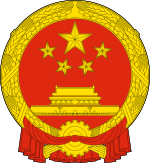SASAC
|
国务院国有资产监督管理委员会 Guówùyuàn Guóyǒu Zīchǎn Jiāndū Guǎnlǐ Wěiyuánhuì |
|

|
|

Logo of SASAC
|
|
| Agency overview | |
|---|---|
| Formed | 10 March 2003 |
| Headquarters | Beijing |
| Agency executives |
|
| Parent agency | State Council of the People's Republic of China |
| Website | www.sasac.gov.cn |
| State-owned Assets Supervision and Administration Commission of the State Council | |||||||
| Simplified Chinese | 国务院国有资产监督管理委员会 | ||||||
|---|---|---|---|---|---|---|---|
| Traditional Chinese | 國務院國有資產監督管理委員會 | ||||||
| Literal meaning | State Council State-owned Asset(s) Supervision-Administration Commission | ||||||
|
|||||||
| Abbreviation | |||||||
| Simplified Chinese | 国务院国资委 | ||||||
| Traditional Chinese | 國務院國資委 | ||||||
| Literal meaning | State Council State Asset(s) Commission | ||||||
|
|||||||
| Transcriptions | |
|---|---|
| Standard Mandarin | |
| Hanyu Pinyin | Guówùyuàn Guóyǒu Zīchǎn Jiāndū Guǎnlǐ Wěiyuánhuì |
| Transcriptions | |
|---|---|
| Standard Mandarin | |
| Hanyu Pinyin | Guówùyuàn Guózīwěi |
The State-owned Assets Supervision and Administration Commission of the State Council (SASAC) is a special commission of the People's Republic of China, directly under the State Council. It was founded in 2003 through the consolidation of various other industry-specific ministries. As part of economic reform, nearly half of state-owned enterprises were sold off in the form of stocks. SASAC is responsible for managing the remaining SOEs, including appointing top executives and approving any mergers or sales of stock or assets, as well as drafting laws related to state-owned enterprises. As of 2006[update], its companies had combined revenues of more than $1 trillion and owned assets of more than $1.5 trillion, making it among the largest economic entities in the world.
The chairman of the commission is Xiao Yaqing.
Affiliated industrial associations include:
As of 20 December 2016, SASAC oversees 102 centrally owned companies. Based on the state-owned enterprise restructuring plan, the SASAC directly supervised SOE were reduced by the end of 2010 as small companies were merged into big state-owned enterprise giants.
...
Wikipedia
